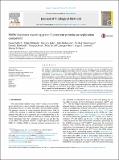Files in this item
FMDV replicons encoding green fluorescent protein are replication competent
Item metadata
| dc.contributor.author | Tulloch, Fiona Ashley | |
| dc.contributor.author | Pathania, Uday Singh | |
| dc.contributor.author | Luke, Garry Alec | |
| dc.contributor.author | Nicholson, John | |
| dc.contributor.author | Stonehouse, Nicola J | |
| dc.contributor.author | Rowlands, David J | |
| dc.contributor.author | Jackson, Terry | |
| dc.contributor.author | Tuthill, Toby | |
| dc.contributor.author | Hass, Juergen | |
| dc.contributor.author | Lamond, Angus I | |
| dc.contributor.author | Ryan, Martin Denis | |
| dc.date.accessioned | 2014-10-27T10:31:03Z | |
| dc.date.available | 2014-10-27T10:31:03Z | |
| dc.date.issued | 2014-12-01 | |
| dc.identifier | 154954084 | |
| dc.identifier | 82ebd01c-e8a2-4313-a883-408e9ca475bd | |
| dc.identifier | 84907521743 | |
| dc.identifier | 000343847600006 | |
| dc.identifier.citation | Tulloch , F A , Pathania , U S , Luke , G A , Nicholson , J , Stonehouse , N J , Rowlands , D J , Jackson , T , Tuthill , T , Hass , J , Lamond , A I & Ryan , M D 2014 , ' FMDV replicons encoding green fluorescent protein are replication competent ' , Journal of Virological Methods , vol. 209 , pp. 35-40 . https://doi.org/10.1016/j.jviromet.2014.08.020 | en |
| dc.identifier.issn | 0166-0934 | |
| dc.identifier.other | ORCID: /0000-0002-0012-0614/work/47136056 | |
| dc.identifier.other | ORCID: /0000-0003-0859-2867/work/31161342 | |
| dc.identifier.uri | https://hdl.handle.net/10023/5574 | |
| dc.description | The authors gratefully acknowledge the support of the Wellcome Trust (089209/Z/09/Z) and particularly the support providedby Biological and Biotechnological Sciences Research Council (BBSRC) (BB/K003801/1). | en |
| dc.description.abstract | The study of replication of viruses that require high bio-secure facilities can be accomplished with less stringent containment using non-infectious ‘replicon’ systems. The FMDV replicon system (pT7rep) reported by Mclnerney et al. (2000) was modified by the replacement of sequences encoding chloramphenicol acetyl-transferase (CAT) with those encoding a functional L proteinase (Lpro) linked to a bi-functional fluorescent/antibiotic resistance fusion protein (green fluorescent protein/puromycin resistance, [GFP-PAC]). Cells were transfected with replicon-derived transcript RNA and GFP fluorescence quantified. Replication of transcript RNAs was readily detected by fluorescence, whilst the signal from replication-incompetent forms of the genome was >2-fold lower. Surprisingly, a form of the replicon lacking the Lpro showed a significantly stronger fluorescence signal, but appeared with slightly delayed kinetics. Replication can, therefore, be quantified simply by live-cell imaging and image analyses, providing a rapid and facile alternative to RT-qPCR or CAT assays. | |
| dc.format.extent | 6 | |
| dc.format.extent | 1038635 | |
| dc.language.iso | eng | |
| dc.relation.ispartof | Journal of Virological Methods | en |
| dc.subject | FMDV | en |
| dc.subject | Replicon | en |
| dc.subject | Fluorescence | en |
| dc.subject | Replication | en |
| dc.subject | QH301 Biology | en |
| dc.subject.lcc | QH301 | en |
| dc.title | FMDV replicons encoding green fluorescent protein are replication competent | en |
| dc.type | Journal article | en |
| dc.contributor.sponsor | BBSRC | en |
| dc.contributor.sponsor | The Wellcome Trust | en |
| dc.contributor.institution | University of St Andrews. School of Biology | en |
| dc.contributor.institution | University of St Andrews. Biomedical Sciences Research Complex | en |
| dc.identifier.doi | 10.1016/j.jviromet.2014.08.020 | |
| dc.description.status | Peer reviewed | en |
| dc.identifier.grantnumber | BB/K003801/1 | en |
| dc.identifier.grantnumber | 089209 | en |
This item appears in the following Collection(s)
Items in the St Andrews Research Repository are protected by copyright, with all rights reserved, unless otherwise indicated.

